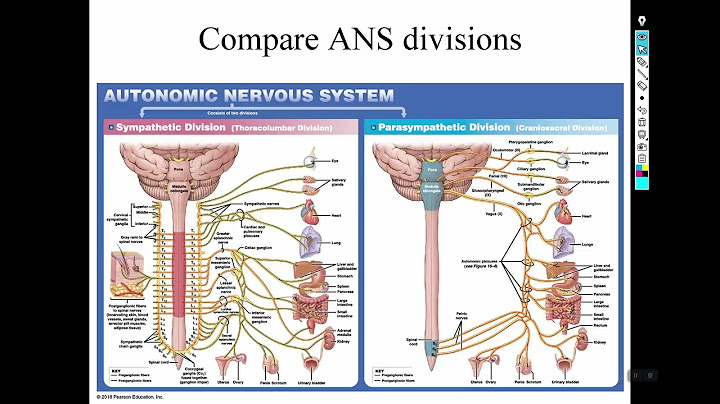The endocrine system is an organ system which consists of various glands around the body (examples of which are the Hypothalamus, Pituitary gland, Parathyroid gland, Thyroid gland, Adrenal glands, Pancreas, Ovaries in females and Testies in the male body). These glands secrete hormones directly into the bloodstream. The nervous system is an organ system consisting of many different specialized cells (called neurons) which ‘coordinate the actions of a person and transmit signals between different parts of its body’[1]. In our bodies the nervous system is made up of two parts: the central nervous system and the peripheral nervous system. The central nervous system consists of the brain, spinal cord, and the retina. The peripheral nervous system consists of sensory neurons, clusters of neurons which are called ganglia, and nerves which connect them to each other and to the central nervous system. All of these regions are all interconnected by means of complex neural pathways. The hypothalamus is a gland which is found in the brain and it links the endocrine system and the nervous system together. The hypothalamus receives different information from all of the main areas that make up the brain and other organs. The hypothalamus is able to registers a variety of feeling and sensations such as pain, temperature, hunger, thirst, stress, fear, and anger. Then, once this information has been sent to the hypothalamus (part of the endocrine system) and has been registered, it works with the autonomic nervous system (part of the peripheral nervous system) to affect and administer changes to various organs. Examples of any effects or changes are an increased heart or lung rate, ‘increased blood flow to your skeletal muscles or digestive organs, changes in how much light enters your eyes and how well your eyes can focus on distant objects, production of sweat or shivers, and arousal of sexual organs.’[2] So because of the ability of the hypothalamus to link and affect both the nervous and the endocrine systems, it is called a neuroendocrine tissue; a specialized type of tissue. The endocrine system and the nervous system work in parallel with each other and in conjunction with each other in order to maintain homeostasis, development and reproduction. Both of these organ systems are the communication links of the body and help the body’s life systems to function correctly and in relation to each other. In terms of function, both the nervous and endocrine systems work hand in hand with one another by acting in communication and driving hormonal changes. They both work in maintaining homeostasis and they both respond to internal and external changes to the body. Besides functioning in similar ways they both work in conjunction with each other. An example of this can be seen in a mother’s release of milk. When a baby sucks at the nipple of its mother, the sensory cells in the nipple send out signals to the hypothalamus. The hypothalamus then responds by releasing the hormone oxytocin from the posterior pituitary gland. The oxytocin is released directly into the bloodstream where it moves to its target cell, which for this example is a mammary gland. The mammary gland then responds to the signals from the oxytocin hormone by releasing milk through the nipple. Besides working in conjunction with each other, both systems also affect one another. The adrenal medulla is under the control of nerve cells, but the nervous system’s development is under the control of the endocrine system.[3] Further example as to how the nervous and endocrine systems are interrelated: Someone is walking along a street at night when they spot a group of people in front of them, all of them carrying knives and other threatening objects. Because it is night, the person’s eyes would take some time to adjust and actually spot the group of people. When they do and their eyes detect the group, their brain would tell them that it may harm them. The hypothalamus in the brain, uses the autonomic nervous system to very quickly help the eyes to adjust and to see better. It uses the brain in order to think more quickly, and your heart, lungs, and large skeletal muscles to allow you to run faster if required or fight off the group with more strength. The autonomic nervous system would help in stimulating some of the above reactions by stimulating the release of epinephrine and norepinephrine from another region of the adrenal glands (the inner portion). This is another way in which the nervous and endocrine systems are intertwined in their roles and influences over many of the body’s physiological activities. By way of the endocrine system, the person’s hypothalamus would stimulate the production and the release of cortisol (which is a glucocorticoid) from another region of the adrenal gland (the outside of the adrenal gland). These glucocorticoids would increase the production of glucose, which would therefore ensure that the person has a sufficient amount of energy or fuel in order to fight or to run away from the group of people. In this situation, adrenalin may also be produced from the adrenal medulla (another gland that is part of the endocrine system). The adrenalin hormone is released as a response to the individual’s feelings of anxiety, during exercise (if the person runs away) or fear. This is why adrenalin is known as the fright, flight or fight hormone. These responses (of staying and fighting the group or running from the group) would both require a lot more blood and oxygen to be present in the muscles. If the person is scared, it will cause the brain to send signals to the renal glands which would then begin to pump a large amount of adrenalin into the bloodstream. This would then increase the heart rate and the breathing rate in order to prepare for what the person is going to do (run or fight). The heart rate and breathing rate would increase and the airways of the lungs would widen. The person would now have fast shallow chest breathing as opposed to slow relaxed breathing. The autonomic nervous system is split up into two sub systems; the sympathetic and the parasympathetic nervous system. In the example above it is the sympathetic nervous system which would control the body’s responses. When aroused, this is the system that begins to increase the person’s heart rate and breathing rate, their pupils would begin to dilate and they may begin to start sweating (the fight or flight response). The nerve impulses travel at approximately 150 meters per second which means that this stage of the fight or flight response can take place very quickly; in milliseconds. Once the danger has passed (the group of people have moved away), it is the parasympathetic nervous system which would then counteract the sympathetic nervous system. This is the system that would then help to calm the body, gradually slowing the person’s heart and breathing rates, their pupils would contract and the sweating would stop. Sources: [1] Kandel ER, Schwartz JH, Jessel TM, ed. (2000). “Ch. 2: Nerve cells and behavior”. Principles of Neural Science. McGraw-Hill Professional. ISBN 9780838577011. [2] http://www.drbenkim.com/nervous-endocrine-system.htm [3] http://www.cartage.org.lb/en/themes/sciences/zoology/animalphysiology/endocrinesystem/endocrinesystem.htm DISCLAIMER: The articles on our website are not endorsed by, or the opinions of Shout Out UK (SOUK), but exclusively the views of the author. |

Related Posts
Advertising
LATEST NEWS
Advertising
Populer
Advertising
About

Copyright © 2024 en.ketajaman Inc.


















